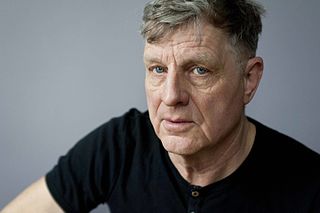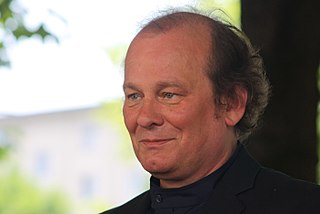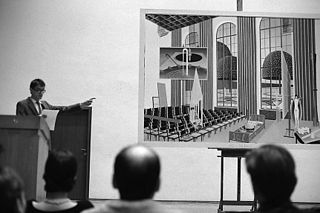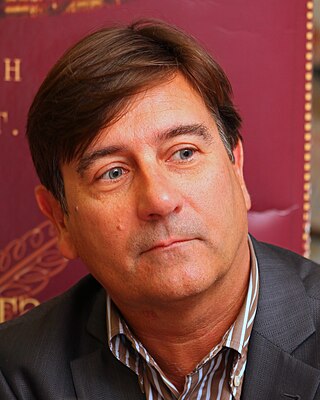Related Research Articles
Otto Wacker (1898–1970) was a German art dealer who became infamous for commissioning and selling forgeries of paintings by Vincent van Gogh. He had gained a good reputation in the 1920s after false starts in various other professions. Since the end of World War II, he lived in East Berlin. A study of his life and times has been written by Modris Eksteins.

Karen Duve is a German author. After secondary school, she worked as a proof-reader and taxi driver in Hamburg. Since 1990 she has been a freelance writer.
Bruno Lohse was a German art dealer and SS-Hauptsturmführer who, during World War II, became the chief art looter in Paris for Hermann Göring, helping the Nazi leader amass a vast collection of plundered artworks. During the war, Göring boasted that he owned the largest private art collection in Europe.

Rainer Fetting is a German painter and sculptor.

Peter Wawerzinek is a German artist and writer.
Wolfgang Beltracchi is a German art forger and artist who has admitted to forging hundreds of paintings in an international art scam netting millions of euros. Beltracchi, together with his wife Helene, sold forgeries of alleged works by famous artists, including Max Ernst, Heinrich Campendonk, Fernand Léger and Kees van Dongen. Though he was found guilty for forging 14 works of art that sold for a combined $45m (£28.6m), he claims to have faked "about 50" artists. The total estimated profits Beltracchi made from his forgeries surpasses $100m.

The Tower of Blue Horses is a 1913 oil painting by the German Expressionist artist Franz Marc. It has been called one of his best works, but went missing in 1945.

Thomas Huber is a Swiss artist who lived and worked in Mettmann near Düsseldorf for several years and is currently resident in Berlin.

Alain Claude Sulzer is a Swiss writer and translator. He was born in Riehen, near Basel. Sulzer became a librarian, but also translated from French, for example parts of Julien Green's diaries. As a journalist he wrote for various newspapers and magazines, including the NZZ. He has published more than ten books and has won a number of literary awards in the process, such as the Rauris Literature Prize (1984), or the Hermann-Hesse-Preis (2009).

Henry Keazor is a German art historian. He is a Professor of Art History at Heidelberg University.
Stefan Moses was a German photographer living in Munich.
Robert Suckale was a German art historian, medievalist and professor at the Technical University of Berlin.

Leo Bendel was a tobacco dealer and art collector.
Hermann Voss was a German art historian and museum director appointed by Hitler to acquire art, much of it looted by Nazis, for Hitler's planned Führermuseum in Linz, Austria.

Ingo Kühl is a German painter, sculptor and architect.
Kathrin Hoffmann-Curtius is a German, independent art historian, who taught for a time at the universities of Tübingen, Hamburg, Trier and Vienna.

Nicolas Mahler is an Austrian cartoonist and illustrator. Die Zeit, NZZ am Sonntag, Frankfurter Allgemeine Sonntagszeitung and Titanic print his comics. He is known for his comics Flaschko and Kratochvil and for his literary adaptations in comic form. His comics have been adapted into films and theatre plays. He was awarded the Max & Moritz Prize and the Preis der Literaturhäuser.
Jean-Christophe Ammann was a Swiss art historian and curator.

Margarete Mauthner was a German art collector, patron, translator and author, persecuted by Nazis because of her Jewish origins. Her works were published by Bruno Cassirer.

Kyung-hwa Choi-ahoi is a South Korean graphic artist, author and university teacher living in Germany, with a focus on drawing. From 2015 to 2019 she was a professor for drawing at the University of the Arts Bremen and has been a professor for drawing at the Weißensee Academy of Art Berlin since 2019. She lives in Hamburg and Berlin.
References
- ↑ Stefan Koldehoff kunstforum.de, retrieved 1 October 2021
- 1 2 3 4 5 Stefan Koldehoff (in German) Kiepenheuer & Witsch 2021, retrieved 1 October 2021
- ↑ Stefan Koldehoff (in German) Nimbus Verlag, 2021, retrieved 1 October 2021
- ↑ Andreas Stopp [in German] (16 March 2017). "Nach 24 Jahren und mehr als 1.200 Sendungen: Markt und Medien – die Letzte!". Deutschlandfunk. Retrieved 23 September 2021.
- ↑ "Stefan Koldehoff erhält den Journalistenpreis des Deutschen Kulturrates". Deutschlandradio . 5 February 2009. Retrieved 23 September 2021.
- 1 2 "Falsche Bilder – Echtes Geld: Der Fälschercoup des Jahrhunderts – und wer alles daran verdiente". galiani.de. Retrieved 23 September 2021.
- ↑ "Die Journalisten des Jahres 2014 von A–Z". mediummagazin.de. Retrieved 23 September 2021.
- ↑ Michael Sontheimer : Erhebliche Fehlerdichte. Rewiew, in taz, 8 March 2014, p. 31.
- ↑ Eine Debatte ohne Ende? : Raubkunst und Restitution im deutschsprachigen Raum on WorldCat